Yuma Territorial Prison from Wikipedia
.
The Yuma Territorial Prison was a prison located in Yuma,
Arizona Territory, United States. It is one of the Yuma Crossing and Associated
Sites on the National Register of Historic Places in the Yuma Crossing
National Heritage Area. The site is now operated as an historical museum
by Arizona State Parks as Yuma Territorial Prison State Historic Park,
a state park in southwestern Arizona.
Prison
The prison accepted its first inmate on July 1, 1876.
For the next 33 years 3,069 prisoners, including 29 women, served sentences
there for crimes ranging from murder to polygamy. The prison was under
continuous construction with labor provided by the prisoners. In 1909,
the last prisoner left the Territorial Prison for the newly constructed
Arizona State Prison Complex located in Florence, Arizona.
High School
From 1910 to 1914 the Yuma Union High School occupied
the buildings. When the school's football team played a game against Phoenix,
with Phoenix favored to win, the Phoenix team branded the Yuma team "criminals"
when Yuma unexpectedly won; the school adopted the mascot with pride, sometimes
shortened as the "Crims"; the school mascot image is the face of a hardened
criminal, and the student merchandise shop is known as the Cell Block.
---------------
Yuma Territorial Prison is a living museum of the Old
West. More than 3,000 desperadoes, convicted of crimes ranging from polygamy
to murder, were imprisoned in rock and adobe cells here during the prison's
33 year existence between 1876 and 1909. The cells, main gate and guard
tower are still standing, providing visitors with a glimpse of convict
life in the Southwest a century ago. |
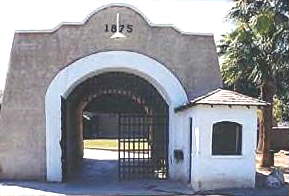
Main Gate to the Yuma Territorial Prison.
.
.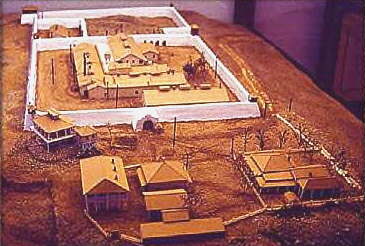
Model of the Territorial Prison at Yuma |
.
Click on images to enlarge
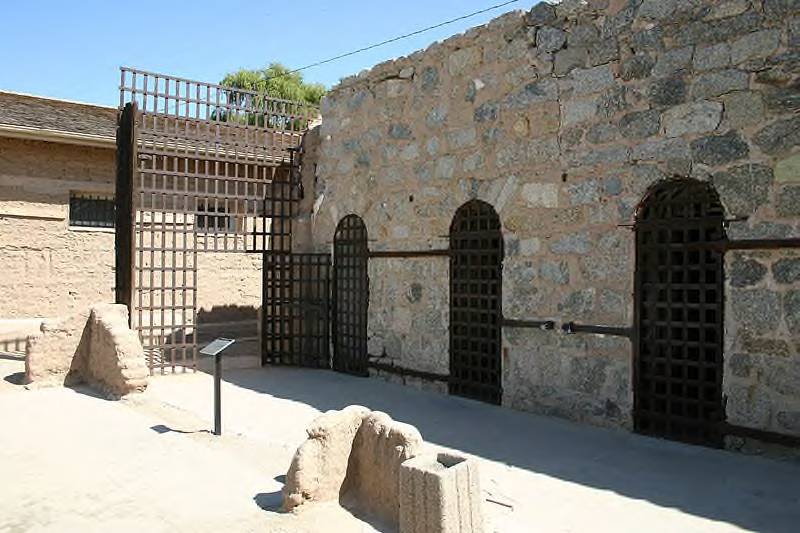
Cells and yard at the Yuma Territorial Prison |

Iron bunk beds inside the prison |
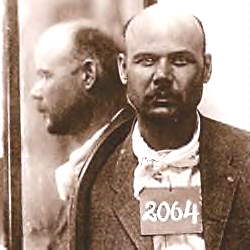
Mug shot of train robber
Burt Alvord
at the prison in 1904 |
|
United States Penitentiary (USP), Leavenworth, Kansas from
Wikipedia
.
| The United States Penitentiary (USP), Leavenworth was
the largest maximum security federal prison in the United States from 1903
until 2005. It became a medium security prison in 2005.
It is located in Leavenworth, Kansas. It is an all-male,
medium-security facility committed to carrying out the judgments of the
Federal Courts.
Background
The civilian USP Leavenworth is the oldest of three major
prisons built on the grounds of Fort Leavenworth. The United States Disciplinary
Barracks (USDB) is four miles (6 km) north and is the sole maximum-security
penal |
.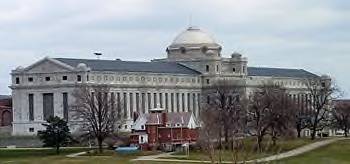 |
facility of the United States Military. The original USDB
opened in 1874 with the current facility opening in 2002. Prisoners from
the original USDB were used to build the civilian prison. In addition,
the military's medium security Midwest Joint Regional Correctional Facility,
located southwest of the new USDB, opened in 2010. The three prisons operate
independently of each other.
In September 2009, the prison population consisted of
1,899 inmates in the main building and 407 in the adjoining minimum security
camp.
The prison was extensively described by Pete Earley, the
only writer at that time who had ever been granted unlimited access to
the prison, in his book, The Hot House. The prison's history has also been
covered extensively in the pictorial history titled U.S. Penitentiary Leavenworth
by Kenneth M. LaMaster. Mr. LaMaster is the retired Institution Historian.
Design
Leavenworth is one of three first generation United States
Penitentiaries built in the early 1900s. Prior to its construction federal
prisoners were held at state prisons. In 1895 Congress authorized the construction
of the federal prison system.
The other two were Atlanta and McNeil Island (although
McNeil dates to the 1870s the major expansion did not occur until the early
1900s).
The prison follows a format popularized at the Auburn
Correctional Facility in New York where the cell blocks were in a large
rectangular building. The rectangular building was focused on indoor group
labor with a staff continually patrolling.
The Auburn system was a marked difference from the earlier
Pennsylvania plan popularized at Eastern State Penitentiary in which cell
blocks radiated out from a central building (and was the original design
for the nearby Disciplinary Barracks before it was torn down and replaced
by a totally new prison).
The St. Louis, Missouri architecture firm of Eames and
Young designed both Leavenworth and the United States Penitentiary, Atlanta.
Leavenworth's prison cells are back to back in the middle
of the structure facing the walls. The prison's walls are 40 feet (12 m)
high, 40 feet (12 m) below the surface and 3,030 feet (920 m) long and
enclose 22.8 acres (92,000 m2).
Its domed main building was nicknamed the "Big Top" or
"Big House." The domed Disciplinary Barracks two miles (3 km) to the north
was nicknamed the "Little Top" until it was torn down in 2004 and replaced
with a newer structure.
The large central structure created various maintenance
problems. It was nicknamed the "Hot House" because of its poor ventilation
even when air conditioning is running. Extensive research by Prison Historian
and author Kenneth M. LaMaster has shown that the institution has never
been referred to as the "Hot House". Books such as Tom White: The Life
of a Lawman and other publications show that the institution has been referred
to as "The Big House", "The Big Top", and "The Big L", but never the "Hot
House". The latter was popularized after a book of the same title was released
by Pete Early in the late 1980s.
The next generation was characterized by the Lewisburg
Federal Penitentiary built in 1931 which started a move away from a huge
central castle like structure. Cell blocks are arranged in a "telephone
pole" format extending out from the central building. This eliminated the
mixing of prisoners of all types in the same building.
Modern federal prisons such as ADX Florence have gone
to smaller buildings spread out over a compound and depend more upon electronic
surveillance.
Historical timeline
1827: Colonel Henry Leavenworth chose
site for new fort.
1875: Fort chosen as the site for
a military prison. Within a year, Fort Leavenworth housed more than 300
prisoners in a remodeled,
supply-depot building.
1894: Secretary of War conceded to
the House Appropriations Committee that War Department could do without
the military prison.
1895 July 1: Congress transferred
the military prison from the War Department to the US Department of Justice.
The Department of Justice
took over the plant and inaugurated the United States Penitentiary. Commandant
of the military prison, James V. Pope. Warden of the
USP, James W. French.
1896: House Judiciary Committee recommended
that the facility be replaced.
1896 June 10: the Congress authorized
a new federal penitentiary.
1897 March: Warden French marched
prisoners every morning two and one-half miles (4 km) from Ft. Leavenworth
to the new site of the
federal penitentiary. Work went on for two and one-half decades.
1899 July 1: Robert W. McClaughry
was appointed Leavenworth's second Warden.
1901 November 10: Joseph Waldrupe
was the first correctional officer to be killed (records dating back to
1901) in the line of duty at
Leavenworth.
1903: Enough space was under roof
to permit the first 418 prisoners to move into the new federal penitentiary.
1904: First Cell house completed
1906 February 1: All prisoners had
been transferred to the new facility, and the War Department appreciatively
accepted the return of its
prison.
1910 May: The Attorney General approved
construction of a separate cellblock for females on the penitentiary grounds—this
plan was later
abandoned.
1913 June: T. W. Morgan, editor of
a newspaper in the small Kansas town of Ottawa, was appointed Leavenworth's
3rd Warden.
1919: Construction of the cellblocks
completed.
1926: Construction of the shoe shops
completed.
1928: Construction of the brush and
broom factory completed.
1929: Construction of the barber shop
and first intraprison murder.
1930 May: the Bureau of Prisons became
a federal agency within the Department of Justice.
1930 September 5: Carl Panzram becomes
the first to be executed (records dating back to 1927) by hanging at Leavenworth.
1934 December 11: President Franklin
Roosevelt authorized the first federal prison industries as a public corporation.
1938 August 12: Robert Suhay and Glenn
Applegate the first double execution (records dating back to 1927) by hanging
at Leavenworth.
1980s & 1990s: The institution
undergoes major renovations to three of its four cellhouses: A, B, and
C. D-Cellhouse today remains the only
cellblock true to its original design.
2005: Federal Bureau of Prisons changes
USP Leavenworth's mission. The BOP decided to change the custody level
of USP Leavenworth
from High / Maximum to Medium while retaining the USP designation for historical
reasons.
2011: The Federal Bureau of Prisons
takes comments on a proposed new 1,500 medium security and 300 minimum
security facility on the
current prison grounds on 144 acres to the west of the current prison and
a 238 acre area to the east.
Notable inmates
| Name |
Status |
Details |
| Samuel R. Caldwell |
. |
First man in America to be arrested for selling marihuana
in violation of the Marijuana Tax Act of 1937 |
| Fredrick Cook |
In 1922, pled guilt to mail fraud and imprisoned until
1930. |
Famous explorer whose claims to be the first to reach
the summit of Mt. McKinley and the North Pole turned out to be fraudulent. |
| Jimmy Burke |
who was sent to prison for the first time at the age
of eighteen in 1949 and once again in 1972 for extortion. |
Gangster |
| James J. Bulger |
He was shipped to Leavenworth out of Alcatraz |
Irish-American gangster sent to Leavenworth for hijacking
and bank robbing. |
| Troy Deon Reddick |
. |
Bank robber and rapper know as Da' Unda' Dogg |
| Phillip Garrido |
. |
Sent to Leavenworth for kidnap of Katherine Callaway,
later kidnaped Jaycee Dugard |
| Fritz Joubert Duquesne |
. |
Nazi spy and leader of the Duqesne Spy Ring, the largest
convicted espionage case in United States history. |
| Victor Feguer |
. |
last federal fugitive executed before Timothy McVeigh. |
| John "Sonny" Feanzese |
. |
A legendary New York gangster and a high ranking member
of the Colombo crime family. |
| Antonio Fernandez |
. |
aka Kine Tone and current Inca of the Latin Kings gang. |
| Gus Hall |
. |
former leader of the Communist Party USA, indicted under
the Smith Act |
| Thomas James Holden |
. |
murderer and escapee, FBI Ten Most Wanted Fugitive #1,
1950 |
| Michael Nunn |
. |
Former IBF Middleweight and the WBA Super Middleweight
Boxing Champion/ |
| Orba Elmer Jackson |
. |
escapee and post office robber, FBI Top Ten Most Wanted
#7, 1950. |
| George "Machine Gun " Kelly |
. |
Depression era gangster. |
| Randy Lanier |
Transferred |
1986 Indianapolis 500 rookie of the year. Guilty of engineering
a Continuing Criminal Enterprise and conspiring to distribute more than
1,000 pounds of marijuana. |
| Felix Mitchell |
Stabbed to death in 1986, just months into his prison
term |
notorious drug kingpin from Oakland, California. |
| Byron "Bam" Morris |
|
former NFL player, played in Super Bowl XXX |
| Ramsey Muniz |
Imprisoned for life on drug violations |
Raza Unida Party political activist in Texas, gubernatorial
candidate in 1972 and 1974. |
| "Boss" Tom Penergast |
. |
Kansas City politician who handpicked HArry Truman for
US Senate. |
| Tom Petters |
As of 2010, held in USP, Leavenworth |
Former Minnesota CEO convicted in a $.6 billion Ponzi
scheme, the largest fraud case in state history. |
| George "Bugs" Moran |
. |
Irish gangster who battled Al Capone for the control
of Chicago's criminal underworld, who died one month into his sentence
from lung cancer and is buried in the institution cemetery |
| Richard Case Nagell |
. |
the so-called "Man Who Knew To Mach" |
| Carl Panzram |
. |
Serial killer. Executed for the murder of Institution
Laundry Foreman Rogert G. Warnke |
| John Paul, Sr. |
released 1999 |
racecar driver, importing marijuana, tax evasion, possession
of false passport and attempted first-degree murder of a federal witness. |
| Keinard Peltier |
As of 1999 serving his time at UPS Lewisburg. |
American Indian Movement leader, convicted of murdering
two FBI agents, FBI Ten Most Wanted Fugitive #335, 1975 |
| James Earl Ray |
1955-58 |
Charged with forging documents - later assassin of Martin
Luther King |
| Leslie Isben Rogge |
. |
Bank robber, FBI Top Ten Most Wanted #439,1990 |
| Robert Stroud |
Transferred to Alcatraz on Dec 19, 1942 |
Became famous as the "Bird Man of Alcatraz" for studying
and raising canaries, making several important contributions to avian pathology,
entirely from his cell within Leavenworth. |
| Thomas Silverman |
Regarded as one of the prison Bureau's most dangerous
prisoners; was held in Leavenworth's basement in a "No Human Contact" Status;
transferred to ADX Florence supermax in Florence,
Colorado |
Murder |
| Michael Vick |
Released in 2009 |
NFL quarterback formerly with the Atlanta Falcons, pleaded
guilty to operating an unlawful six-year-long interstate dog fighting venture
known as "Bad Newz Kennels". |
| Ricardo Flores Magon |
He became equally at odds with US authorities
and eventually died in Leavenworth in 1922, probably
dying from long-standing health impairments. |
Mexican anarcho-syndicalist intellectual who was in the
US during the Mexican Revolution. |
| Anthony Carollo |
Deceased |
Boss of the Lucchese crime family and convicted in the
Mafia Commission Trial. |
Famous escapees
Basil Banghart escaped from Leavenworth a total of three
times. He escaped federal custody a fourth time while awaiting return to
Leavenworth.
Executions
On September 5, 1930, Carl Panzram, under a federal death
sentence for murder, was hanged at USP Leavenworth. On August 12, 1938,
two men under the sentence of death for murder, Robert Suhay and Glenn
Applegate, were hanged at USP Leavenworth.
Officer deaths
Five officers were killed in the line of duty at Leavenworth.
Joseph B. Waldrupe, November 10, 1901,
from injuries received during institution mutiny and mass escape on November
7, 1901.
Andrew F. Turner, March 26, 1916.
Murdered by inmate Robert Stroud aka the Birdman of Alcatraz.
Edgar A. Barr, March 19, 1917. Murdered
during an altercation with an inmate.
John W. Johnson,, September 29, 1974.
Murdered during an altercation with an inmate.
Wayne L. Selle, July 31, 1973. Murdered
by inmates during an institution riot.
In addition, two non-officers were killed in the line
of duty between 1922 and 1929:
Andrew H. Leonard, Captain, November
14, 1922. Murdered during an altercation with an inmate in which six other
officers received
life-threatening injuries.
Robert G. Warnke, Laundry Foreman,
June 20, 1929. Murdered in institution laundry building by serial killer
Carl Panzram.
|
Texas State Penitentiary at Huntsville from Wikipedia
| Texas State Penitentiary at Huntsville or
Huntsville Unit (HV), nicknamed "Walls Unit," is a Texas state prison located
in Huntsville, Texas, United States. The approximately 54.36-acre
(22.00 ha) facility, near Downtown Huntsville, is operated by the Correctional
Institutions Division of the Texas Department of Criminal Justice, administered
as within Region I. The facility, the oldest Texas state prison, opened
in 1849. The unit houses the State of Texas execution chamber. It is the
most active execution chamber in the United States, with 423 executions
between 1982 and 2008.
History
The prison's first inmates arrived
on October 1, 1849. The unit was named after the City of Huntsville. Originally
Huntsville Unit was only for White Texans; the only penalties available
to Black Texans were whipping and hanging. During the American Civil War,
prisoners at Huntsville produced tents and uniforms for Confederate forces
at the prison textile factory. After the American Civil War ended, Huntsville
Unit was the only prison in the former Confederate States of America to
remain.
Originally women in the Texas Prison
System were housed in the Huntsville Unit. Beginning in 1883 women were
housed in the Johnson Farm, a privately-owned cotton plantation near Huntsville.
Historically the prison served as
the administrative headquarters of the Texas Prison System and the Texas
Department of Corrections; the superintendent and the other executive officers
worked in the prison, and all of the central offices of the system's departments
and all of the permanent records were located in the prison.
In 1974, the prison was the site
of an eleven-day siege, one of the longest hostage-taking sieges in United
States history. Three armed inmates (Fred Carrasco, Ignacio Cuevas, and
Rudy Dominquez) held several hostages in the education department. The
ring leader, Carrasco, had been a porter in the chapel. Cuevas usually
worked in the inmate dining hall. Ten hostages were employees of the prison
system: two were educators, and one was a guard. Later on, the prison chaplain
would also become a hostage. Four prisoners were also held as hostages.
On the |
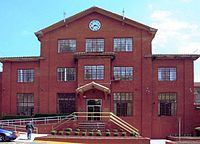
815 12th Street Huntsville, Texas
77342
Capacity 1,705
Opened 1849
Notable prisoners:
Chad Butler ("Pimp C")
Duane "Dog" Chapman
John Wesley HArdin
Satana
.
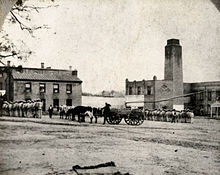
Huntsville Unit's yard during the 1870s |
final day, the inmates tried to escape
using chalkboards and hostages as shields. Dominquez was killed in the
attempt. Carrasco killed Elizabeth Beseda, then shot himself. Julia Standley
was also killed that day. Ignacio Cuevas was executed on May 23, 1991 for
her murder.
Facility
| The red brick walls lead to the nickname "Walls Unit."
While the prison is officially the Huntsville Unit, the
prison's red brick walls lead to the nickname "Walls Unit." The prison
is 160 miles (260 km) southeast of Dallas. The original cellblock had been
closed for several years prior to 2011.
Release center
The Huntsville Unit serves as one of the TDCJ's regional
release centers for male prisoners. Most male prisoners are released to
be closer to their counties of conviction, approved release counties, and/or
residences. Male prisoners who have detainers, are classified as sex offenders,
have electronic monitoring imposed by the Texas Board of Pardons and Paroles,
and/or have certain special conditions of the Super Intensive Supervision
Program (SISP) are released from the Huntsville Unit, regardless of their
counties of conviction, residences, and/or approved release |
.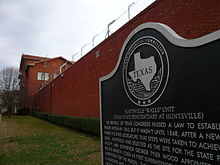
The red brick walls lead to the
nickname "Walls Unit." |
counties. Rick Thaler, the director of the Correctional Institutions
Division, predicted in 2010 that the Huntsville Unit, which serves as the
regional release center for Greater Houston, will remain the TDCJ's largest
release center. Throughout the history of the Texas Prison System 90% of
male prisoners were sent to the unit for the final portions of their sentences
before being released. Starting in September 2010 the TDCJ instead began
to use regional release centers for male prisoners.
Death penalty
The Huntsville Unit is the location of the State of Texas
execution chamber. The TDCJ houses male death row inmates in the Polunsky
Unit and female death row inmates in the Mountain View Unit.
Between 1819 and 1923 the method of execution was hanging
until Texas authorized the use of the electric chair; the use of the electric
chair ended the execution of death sentences by counties in Texas. The
chair– often euphemistically called "Old Sparky" was constructed by inmates.
Between 1924 and 1964, 362 inmates were executed by electrocution. The
chair now resides at the Texas Prison Museum, located on Interstate 45
on the north side of Huntsville which features displays of historical items
from the prison system, including shanks and other items confiscated from
inmates.
Inmates scheduled for execution are brought from death
row to the Walls Unit early in the afternoon of their scheduled execution.
Unlike other states, Texas does not allow inmates a special meal, because
of abuse of the privilege by past prisoners and the rationale that they
did not offer a meal to their victims and therefore should not be allowed
a special recognition. Inmates can, but are not required to, make a last
statement prior to their execution. By law executions are scheduled to
begin after 6:00 p.m. Huntsville (Central) time. The inmates are housed
until that time about 30 feet from the door of the execution chamber; the
Texas Death House is located at the northeast corner of the Walls Unit,
just below the #1 picket. There is no law prohibiting multiple executions
in a single day, but this has not happened since September 1951.
The execution chamber is a 9-foot (2.7 m) by 12-foot (3.7
m) room with turquoise walls and a gurney. When Jim Willett was the warden
of Huntsville Unit, he added a pillow to the gurney. Two adjacent rooms,
which view into the execution room through glass windows, house two groups.
One room is reserved for the family or families of the crime victim(s).
The other is for the family of the condemned.
|
.
All articles submitted to the "Brimstone
Gazette" are the property of the author, used with their expressed permission.
The Brimstone Pistoleros are not
responsible for any accidents which may occur from use of loading
data, firearms information, or recommendations published on the Brimstone
Pistoleros web site. |
|